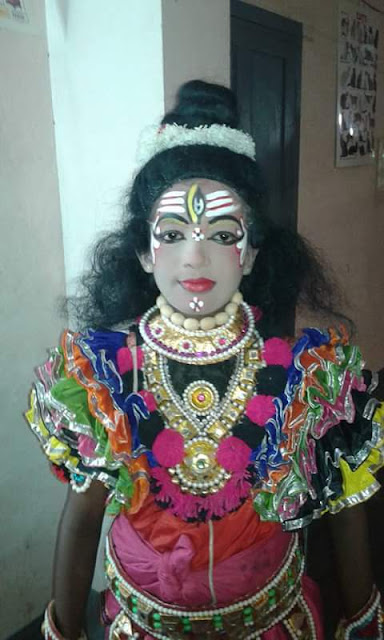Yakshagana
Yakshagana is a folk theater form that combines dance, music, dialogue, costume, make-up, and stage techniques with a unique style and form. This folk theater style is mainly found in the coastal districts and the Malenadu region of Karnataka, India. Yakshagana is traditionally presented from dusk to dawn. Yakshagana is popular in the districts of Uttara Kannada, Shivamogga, Udupi, Dakshina Kannada and Kasaragod district of Kerala. Traditionally, Yakshaganas would go on all night. It is sometimes called as Aata in both Kannada and Tulu.
Yakshagana
consists of Himmela and a Mummela that means background musicians and mummela
means dance and dialog group, which together perform a Yakshagana Prasanga. There
are two types of styles in Yakshagana they are Badagutittu and Tenkutittu.
Badagutittu
The Badagutittū style of Yakshagana
Costume. The Badagutittu style is prevalent in Uttara Kannada District;
it makes use of a typical Karnataka chande. The Badagutittu style was
popularized by Shivarama Karanthas, Yakshagana Mandira," presented at
Saligrama Village in Dakshina Kannada as a shorter more modern form of
Yakshagana.
Tenkutittu
One
of the traditional variations, the tenkutittu
style, is prevalent in Dakshina Kannada, Kasaragod District, western parts of
Coorg , and few areas of Udupi district. The influence of Karnatic Music is
apparent in tenkutittu, as evidenced by the type of maddale used and in
bhaagavathike. Yakshagana is influenced more by folk art blended with classical
dance aspects. In tenkutittu, three iconic set of colors are used: the Raajabanna, the Kaatbanna, and the Sthreebanna. The himmela in the tenkutittu style is more
cohesive to the entire production. Rhythms of the chande and maddale coupled
with the chakrataala and jaagate of the bhaagavatha create an
excellent symphonic sound. The dance form in tenkutittu strikes the attention
of the audience by 'Dheengina' or 'Guttu'. Performers often do dhiginas (jumping spins in the air)
and will continuously spin (sometimes) hundreds of times. Tenkutittu is noted
for its incredible dance steps; its high flying dance moves; and its
extravagant rakshasas (demons).
Tenkutittu
has remained a popular form and has its own audience outside the coastal areas.
The dharmasthala and kateelu durgaparameshwari melas are the two most popular
melas that have helped to popularize this form.
Important
Components in Yakshagana is,
Raga:
Yakshagana Raga refers to melodic framework used
in Yakshagana. It is based on pre-classical melodic forms that comprise a
series of five or more musical notes upon which a melodies founded. Ragas in
Yakshagana are closely associated with a set of melodic forms called mattu. In
the Yakshagana tradition, ragas are associated with different times of the
night throughout which the Yakshagana is performed.
Tala:
Yakshagana Tala is frameworks for rhythms in
Yakshagana that are determined by a poetry style called Yakshagana Padya. Tala also decides how a composition is to be
enacted by the dancers. It is similar to tala in other forms of Indian music,
but differs from them structurally. Each composition is set to one or more
talas, rendered by the himmela percussion artist’s play.
Prasanga and literature
Yakshagana Padya or Yakshagana Prasanga is a
collection of poems written to form a music drama. The poems are composed in
well known Kannada metres, using a frame work of ragas and talas. The
collection of Yakshagana poems forming a musical drama is called a Prasanga.
In Yakshagana
Maddale, Taala( Bells), Chande, these types of instruments are using. Traditionally,
Badagutittu Yakshagana ornaments are made out of light wood, pieces of mirror,
and colored stones. Lighter materials, such as thermocol, are sometimes used
today, although ornaments are still predominantly made of woodwork.
Yakshagana
costumes consist of headgear (Kirita or Pagade), Kavacha that decorates the
chest, Buja Keerthi (armlets) that decorate the shoulders, and belts (Dabu)—all
made up of light wood and covered with golden foil. Mirror work on these
ornaments helps to reflect light during shows and add more color to the
costumes. Armaments are worn on a vest and cover the upper half of the body.
The lower half is covered with kacche, which come in unique combinations of
red, yellow, and orange checks. Bulky pads are used under the kachche, making
the actors' proportions different in size from normal.
The
character, Bannada Vesha, is used to depict monsters. This often involves
detailed facial makeup taking three to four hours to complete. Males play the
female roles in traditional Yakshagana. However, more recently, yakshagana has
seen female artists, who perform in both male and female roles. The character
of Stree Vesha makes use of sari and other decorative ornaments.
(Source:Wikipedia)

No comments:
Post a Comment